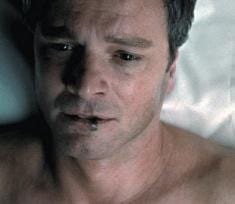A Single Man is one of the best gay movies ever. That it marks the feature debut of fashion-designer-turned-film-director Tom Ford is nothing short of amazing.
George Falconer is an English professor teaching at an unnamed college in suburban LA in the early 1960s. He’s a Brit and a gay, living at a distance from his neighbours. Compounding his outsider status is a keen intelligence — observant and world-weary — and a secret, profound grief over the recent death of his lover of many years.
Already garnering Oscar buzz, Colin Firth gives a heart-wrenching performance, letting George’s churning inner life bubble to the surface in tiny details: his sardonic smile and sparkling, watchful eyes. An added bonus: Firth hasn’t looked this handsome in years, in his Mad Men suits (designed by Ford) and well-coifed hair. (As Firth has aged, directors keep making him sport a long-haired, bohemian look that ends up more mangy than Byronic. Here he’s back as the sexy middle-aged man we all want him to be. Oh, Mr Darcy.)
The movie charts one day in George’s life. It’s eventful; he is planning to kill himself. So George gives a star turn in his last class (Aldous Huxley’s After Many a Summer), ties up his finances, has one last boozy dinner with his gal pal Charlotte (Julianne Moore in another knockout supporting role), visits an old haunt near the beach where he met his lover during the tail end of World War II, and hooks up with a flirtatious male student (Nicholas Hoult).
George’s personal crisis is writ large in seemingly idyllic southern California. Every building and interior is a modernist gem; every bouffant hairdo bursts with confidence. Even the smog-laden skies are a beautiful azure. But the news broadcasts bristle with the Cuban Missile Crisis; the movie houses are playing Alfred Hitchcock’s Psycho. This bucolic world is haunted. Perhaps the American Dream is empty. The world might end tomorrow in a nuclear holocaust.
Christopher Isherwood, the English-born American novelist (most famous for The Berlin Stories, a collection that inspired the play I Am a Camera and the musical Cabaret), published A Single Man in 1964 at the age of 60. It was his favourite of all his novels. He wrote it during a difficult period in his relationship with his young lover, Don Bachardy (30 years his junior). The couple was 10 years or so into their 35-year relationship (which lasted until Isherwood’s death in 1986), and Bachardy had begun fooling around. Isherwood was forced to confront the possibility of life without him and the nature of their cross-generational love.
The film’s versions of George and Charlotte are much more beautiful and stylish, more bourgeois, than Isherwood’s. Under Ford’s direction, their modish trappings become just that, trappings. George puts on his suit like it’s armour, a costume for the role he has to play. Charlotte makes up her face with obsessive detail.
In his equally obsessive attention to style and period detail, Ford makes his characters look as if they live inside vintage booze or car advertisements. This film is art-directed into a tizzy. Perhaps it’s all an attempt to manifest some of the novel’s intriguing commentary. Isherwood’s George goes on a delightful rant in response to a colleague’s snobbish dismissal of American culture, specifically generic motels that lack character. “An American motel room isn’t a room in an hotel,” George lectures, “it’s the room, definitively, period. There is only one: The Room. And it’s a symbol — an advertisement in three dimensions, if you like — for our way of life….
“The Europeans hate us because we’ve retired to live inside our advertisements, like hermits going into caves to contemplate. We sleep in symbolic bedrooms, eat symbolic meals, are symbolically entertained — and that terrifies them…. Essentially we’re creatures of spirit. Our life is all in the mind.”
It’s a critique of what Isherwood saw as the old world’s fetishization of objects and taste. I’m not sure if Ford is advancing that critique or succumbing to it. And I’m not sure Isherwood would mind the elision.
Ford and cowriter David Scearce played fast and loose in their adaptation — they had to, since the novel exists mostly as interior monologues.
The most shocking change is the suicide storyline; in Isherwood’s original, George is sad and bereft, not suicidal. It’s a brave, somewhat melodramatic choice that works by externalizing George’s personal and existential crisis.
I hope other reviewers won’t divulge how the story plays out (I won’t). But it’s difficult not to discuss the film’s ending because it’s so perfectly perfect. It still haunts me months after seeing the film for the first time. The surprise — for those, like me, who are easily surprised (and who hadn’t read the book beforehand) — is integral to its beauty. So try to see the film before someone spoils it.
Another difference is how the era’s pervasive homophobia is made much more explicit. When a cousin calls to tell George of his lover’s death, he tells George the funeral is “just for family.” In a drunken play for George’s affections, Charlotte casually and cruelly dismisses his love of 16 years by asking if he ever wanted a “real relationship.” In the book, these kinds of slights are conjured up by George — which isn’t the same thing as being imaginary. Like many a homosexual, George anticipates barbs in order to avoid them.
Novelist Edmund White described A Single Man as “one of the first and best novels of the modern gay liberation movement.” A set piece of both the film and book is the “invisible minority” speech that George gives to his class where he tries to draw parallels between different ethnic minorities and homosexuals (though gays are never named explicitly). The film builds that speech into a rousing indictment of today’s politics and economics of fear.
One stylistic flourish of Ford’s is to telescope George’s searching looks through a series of quickly edited, slow-mo close-ups where the film colour shifts to red. By complimenting a secretary’s looks, George literally puts the bloom on her lips. As he steals glimpses of topless young men playing tennis (calling to mind Isherwood’s redolent phrase for our uniquely gay — or is just male? — gaze: “the lizard-quick glance of a veteran addict”), their skin tones actually heat up.
One abiding metaphor from A Single Man is that we are all books, without self-knowledge, searching for someone to read us, to look us in the face and understand. We are all desperate to transcend our physical isolation and fear, to connect, to break out of the prison of our own bodies, our own solitude, our fast-fading lives.
To seek love now, without repudiating past love, to seek life now, to be in the moment and really see the world around us — that’s the tantalizing realization that George is reaching for. Intelligent and melancholy, A Single Man is a moving love letter to life.
A Single Man opens:
- Toronto: Fri, Dec 11
- Vancouver: Fri, Dec 25
- Montreal: Fri, Dec 25
- Ottawa: Fri, Jan 8
Xtra.ca videographer and fab magazine associate editor Matt Thomas caught up with director Tom Ford, and actors Julianne Moore and Colin Firth at the 2009 Toronto International Film Festival. Check out our video below:


 Why you can trust Xtra
Why you can trust Xtra


